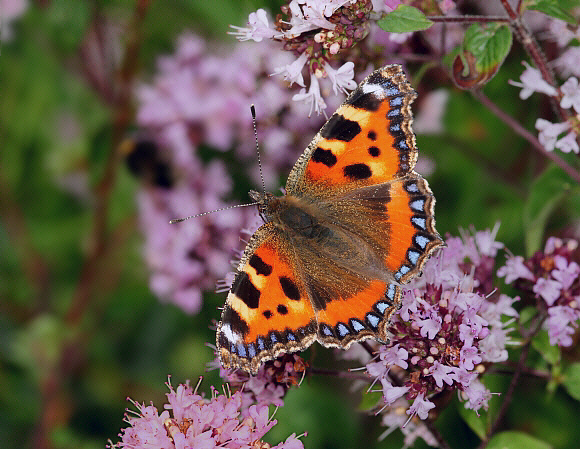 Aglais urticae, Noar Hill, Hampshire – Adrian Hoskins
Aglais urticae, Noar Hill, Hampshire – Adrian Hoskins
Introduction
The Small Tortoiseshell may have been present on Earth longer than any other butterfly species – a mid-Miocene fossil of Aglais karaganica estimated at 15 million years old is so similar to the modern day Aglais urticae as to be virtually indistinguishable!
Small Tortoiseshells vary considerably in appearance – some examples being a unicolorous dull orange, while others are much redder with contrasting yellow patches. In summers when weather conditions are cool, a high percentage of the butterflies tend to have the black markings enlarged, or merging together. In hot summers, and in warmer parts of the butterfly’s range these markings often become reduced in size.
The race ichnusa, found in mountainous areas of Corsica and Sardinia has a fiery orange ground colour, and lacks the colon of black spots on the forewing. Some authors regard it as a separate taxon. Captive reared adults however closely resemble the normal form, so it seems likely that ichnusa is merely a habitat / climate generated form of urticae.
The Small Tortoiseshell occurs across the whole of Europe and temperate Asia. A closely related and very similar species Aglais caschmirensis is found in mountainous regions of Kashmir, Sikkim, Bhutan and Tibet. In the western Himalayas a third species occurs, Aglais ladakensis, which looks like a very heavily marked version of urticae. The only other member of the genus Aglais milberti is a north American species in which the basal half of the forewings is black, and in which the 2 small black spots in the median area are absent.
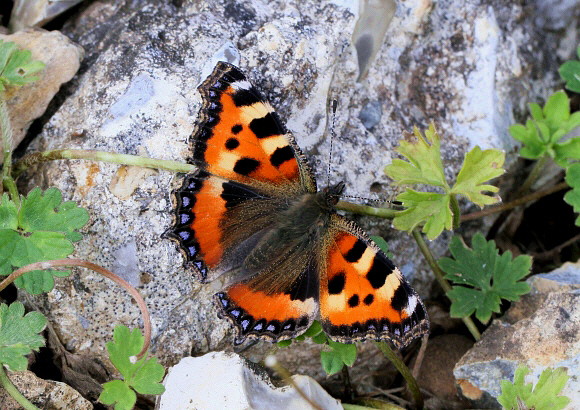
Aglais urticae 2nd brood, Hungerford, Berkshire – Adrian Hoskins
The butterfly has always been subject to dramatic fluctuations in abundance from year to year and in some seasons it can be very scarce. Historically it has always had the ability to bounce back, and was until recently regarded as one of Britain’s most familiar and common butterflies. However after about 1990 the species declined sharply in southern England, until the low point of 2007 when most recorders in Hampshire, Surrey and Sussex failed to see even a single specimen. There was some evidence of a minor come-back in 2008, when most observers saw at least one or two specimens of the late summer brood. Survival of hibernating adults in the cold, prolonged winters of 2008, 2011 and 2012 was exceptionally good, and by the summer of 2013 populations in many areas of Britain were fully recovered.
The cycles of abundance are the result of climatic variations which affect the population dynamics of the butterfly and its parasitoids, particularly the fly Sturmia bella ( Tachinidae ). The latter occurs mainly in warmer climates and first arrived in Britain in 1998. It lays its eggs on nettle leaves. When a Small Tortoiseshell caterpillar eats the leaves, the microscopic eggs are ingested undamaged and pass into its gut. There the eggs hatch, and the resulting grubs bore their way through the soft flesh, consuming non-vital body tissues. When they are almost full grown they eat the vital organs, and then break out through the skin of the dying caterpillar to pupate.
The fly is widespread throughout southern Europe, north Africa and Asia. In Japan it parasitises the caterpillars of a Danaine, Parantica sita. Research by Hirai & Ishii has revealed that P. sita can often survive attack by Sturmia bella – in experiments over 70 percent of infested sita larvae survived and went on to produce perfect adult butterflies. Sadly the Small Tortoiseshell lacks this immunity.
Although current research suggests that Sturmia bella is at least partially responsible for the decline of the Small Tortoiseshell, experiments have shown that only about 18% of Small Tortoiseshells are affected by parasitoids, and Sturmia bella is just one of several that attack the butterfly. It is also notable that other nettle-feeding Vanessids e.g. Peacock, Red Admiral and Comma are apparently less affected, even though their larvae also ingest the Sturmia eggs. The Comma and Peacock in fact increased their numbers substantially between 2005-2009 when urticae was at its nadir. All 3 species have similar biochemistry to that of urticae, so it seems unlikely that they possess a natural immunity. One cannot help wondering therefore why the Small Tortoiseshell seems to have been singled out, while Red Admiral, Comma and Peacock continue to thrive.
Habitats
The Small Tortoiseshell is a highly mobile species which can occur in almost any habitat, including woodlands, grasslands, heaths, gardens, country lanes, and even in city centres. It is a strong flyer, with high powers of dispersal, reaching remote islands and high mountain peaks. Adults have been recorded at altitudes as high as 1200m in Scotland, and larval nests have been found at 3350m. I have watched adults flying near the peak of Ben Lawers in Tayside, and high in the mountains at Langdale Pikes and various other sites in the Lake District.
The butterfly is perhaps commonest on dairy and cattle farmland, where the application of fertilisers and manure enriches the soil, encouraging the growth of stinging nettles Urtica dioica and U. urens.
Lifecycle
In Scotland there is usually only a single generation, emerging in early July, entering hibernation in August, and reappearing in March or April. Elsewhere in Britain there are normally 2 broods per year, one emerging in June, and the other in August. Adults of the latter brood enter hibernation in September or October and awaken the following March. The resident UK population is supplemented by migrants from mainland Europe. The numbers arriving however are normally very low, and have little effect on population levels.
In spring female Small Tortoiseshells are often seen flying around young nettle patches, where they lay their greenish eggs in large untidy heaps of 80-100 on the underside of the upper leaves. Often more than one female will oviposit on the same leaf, sometimes simultaneously. Females typically select young plants growing near the edge of a nettle bed, and always growing in warm, sunny and sheltered conditions. Typical breeding sites include field margins at the bottom of south-facing hills, dykes, riverbanks, railway cuttings, and nettle patches growing on the south side of hedges or walls.
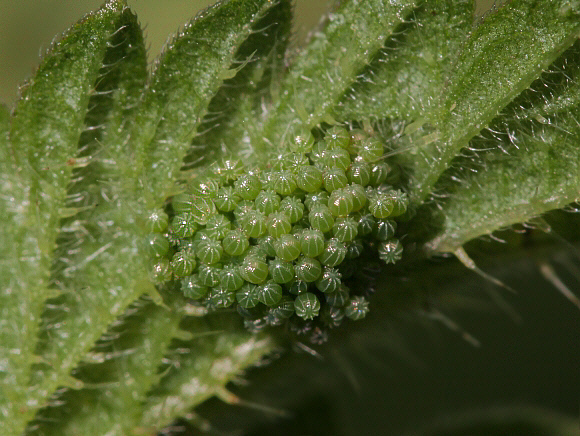
Aglais urticae, egg batch on stinging nettle ( Urtica ), Hampshire – Adrian Hoskins
The summer brood is less fussy about oviposition sites, and will lay on nettle patches in gardens, in woodland glades and rides, and on exposed hilltops.
In June 2009, I watched a female searching for oviposition sites at Martin Down in Hampshire. She spent about half an hour flitting back and forth, settling for a few seconds here and there on various terminal leaves, and took a great deal of time before she eventually found one which suited her. To my eyes it looked no different from any of the other leaves on which she landed, so I assume that she just found that particular leaf easier to grip. Once she had decided where to lay her eggs she clung tenaciously to the leaf, which was constantly battered by strong gusts of wind, until she had laid a batch of about 80 eggs.
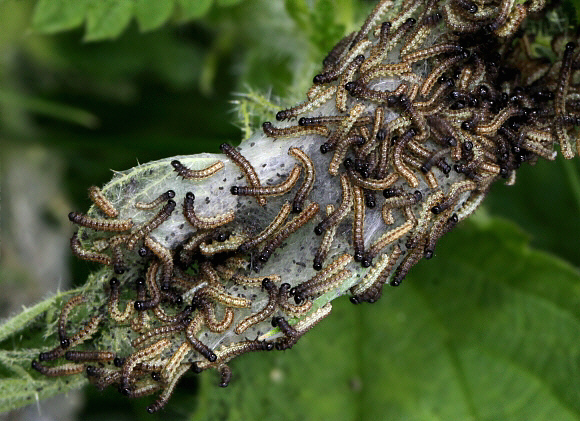
Aglais urticae, 1st instar larvae on Urtica, Hungerford, Berks – Adrian Hoskins
The eggs hatch after about 12 days. Immediately after hatching, the larvae devour their empty egg shells, and then spin a communal silk web around the terminal leaves of the nettles. They shelter within the web at night, or in adverse weather conditions, and feed avidly whenever the sun shines. If disturbed the larvae react in unison, wriggling and jerking as a defence against parasitoid wasps or flies. Nevertheless a high proportion of larvae turn out to be parasitised, usually by the Tachinid fly Phryxe vulgaris. When young, they can easily be mistaken for the caterpillars of the Peacock, but Small Tortoiseshell larvae are paler, and even when quite small it is usually possible to discern pale lines running along their backs.
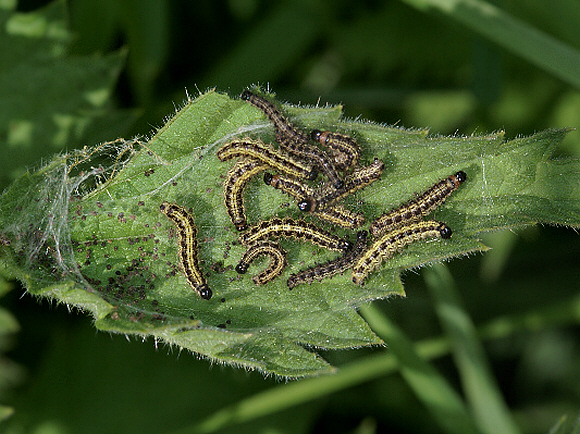
Aglais urticae, 2nd instar larvae on stinging nettle, Dorset – Adrian Hoskins
As they grow, they split up into progressively smaller groups, spinning a new web after each moult. The final instar sees a change in behaviour, with the larvae abandoning their webs to live solitarily. By this time they are a dull blackish colour, spiky, with broad yellow lines running along their backs and sides. These lines are usually prominent, but in some batches of larvae they can be pale and obscure. The fully grown larvae can often be seen curled in a J-shaped posture, resting on nettle leaves, and if disturbed will coil into a tight circle and drop to the ground.
The chrysalis is variable in colour, ranging from grey to olive or buff, often with a pinkish or golden metallic sheen. It can be found suspended by the cremaster, on woody stems, fence posts, walls, or beneath the stems or leaves of nettles. The adults emerge at dawn, about 12 days after pupation.
Adult behaviour
Over-wintered adults typically awaken in late March or early April, and remain on the wing until early May. They are usually seen as singletons, nectaring at dandelion, daisies or sallow catkins, often in the vicinity of nettle patches.
On cool days in spring they do not bask, but instead warm themselves up by shivering their wings prior to flight. The rapid shivering generates warmth by friction, and enables the butterfly to fly even in quite cool conditions. On warm days they frequently bask on bare soil or low foliage, but hot sunny conditions cause them to settle for long periods on bare soil with their wings closed, at which time the sombre ‘tortoiseshell’ pattern on the underside affords them excellent camouflage.

Aglais urticae 1st brood, Hungerford, Berkshire – Adrian Hoskins
Males establish vantage points in the early afternoon, from which they await passing females. When a female flies by she is intercepted and the courtship ritual begins. The male chases her until she settles on the ground. If she is receptive she opens her wings and the male approaches her from behind, with his wings also open. He then steps onto her hindwings, which he vigorously drums with with his antennae. The pair then fly a short distance and repeat the process. Any other males which attempt to interfere are briskly chased away by the resident male, who then returns to his female to continue wing-drumming.
This bonding process continues for several hours, until just before dusk, when the female accepts the male’s advances. A this point she leads him to a sheltered and shady spot, typically beneath a bush or hedge. Both sexes then hold their wings erect, and the male walks alongside the female, and curves his abdomen to copulate. After about 20 minutes the pair straighten out to face opposite directions. They remain copulated in this position until the following morning.
The summer brood butterflies, which emerge from mid June to early July, will nectar at almost any available wild or cultivated flowers. Their favourite however is undoubtedly creeping thistle. At Noar Hill in July 2009 I watched a female nectaring for over 2 hours at a clump of these flowers. When disturbed by a bee or hoverfly she would leave the thistles and briefly investigate other nearby flowers including marjoram, knapweeds, bramble, scabious and hemp agrimony, but after a quick taste always returned to the thistles.
The second generation is always more abundant than the first, and emerges at the end of August. In late summer Small Tortoiseshells often visit flowery areas in the countryside, where they congregate to nectar at thistles, ragwort and other Compositae. They also commonly visit gardens, where they are strongly attracted to Sedum, Buddleia and michaelmas daisies. Their mission at this time of year is to use every opportunity to gorge on nectar, building up sufficient protein and fat reserves in their bodies to enable them to survive hibernation.
In southern Britain the butterflies fly until late September, when they enter houses, sheds, churches and unheated farm buildings to hibernate. In the north they enter hibernation earlier, in late July or early August, after just a few days on the wing. They often hibernate communally – I’ve often found groups of 3 or 4 nestling together in an attic or outbuilding, and I once found 17 hibernating adults clustered tightly together on the ceiling in a hotel in Tayside, Scotland.
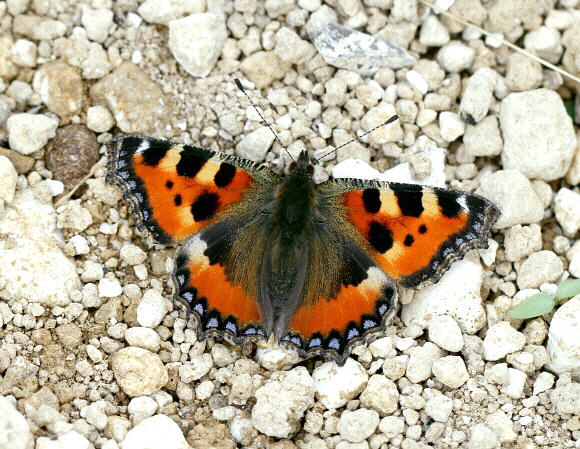
Aglais urticae 2nd brood, Lardon Chase, Berkshire – Adrian Hoskins
